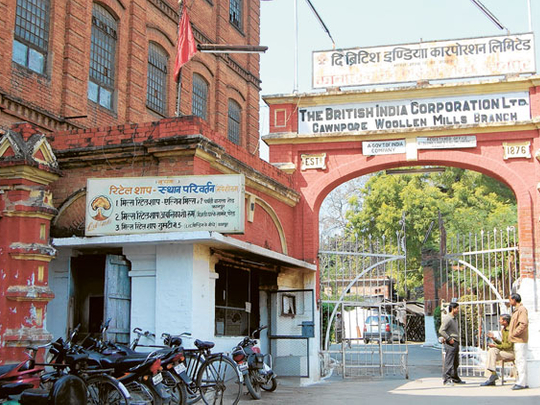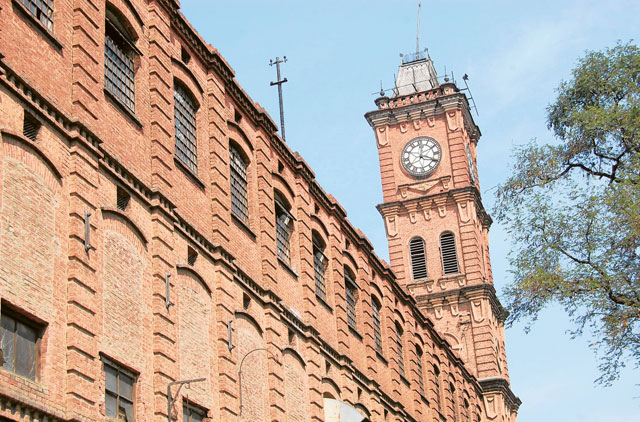
David Massey grew up in the north Indian city of Kanpur listening to the chimes of Lal Imli's clock. His father, Babu Massey, was the clock's keeper. And when his father sought his help to run the clock, he did not have to think twice. David climbed the steps of the 130-foot-high clock tower for the first time when he was 14. "I was in class IX in 1977. I left my examinations midway to assist my father," David said. Babu died two years later, and David, then 16, was appointed the clock's new keeper.
Lal Imli and Kanpur have seen many ups and downs in the last four decades but David has kept Lal Imli's clock ticking for 35 years.
In 1876, five Englishmen — W.E. Cooper, George Allen, Dr Condon, Bevan Petman, and Gavin S. Jones — set up a mill in Kanpur, about 400 kilometres east of Delhi, to manufacture blankets for the soldiers of the British Army. Kanpur then had already become a major British cantonment in north India. The mill, located in Civil Lines neighbourhood in the heart of Kanpur, was named the Woollen Mills, Cawnpore (as the British pronounced and spelt Kanpur). Its products were called Lal Imli (red tamarind), after a tamarind tree that stood in the premises of the factory and bore reddish tamarind. Later, the mill also began making blankets, shawls, wool and other woollen clothes for civilians. The products became so popular that the mill also came to be known as Lal Imli.
Lal Imli's clock tower has also been called the Big Ben of Kanpur. Lal Imli's clock tower and London's Big Ben don't just have similar appearances but also histories.
After the Palace of Westminster, the seat of the British government in London, was destroyed in a fire in 1834, the new palace that was constructed had a clock tower. The clock, popular as Big Ben, is the symbol of London even today. One cannot think of London or England without Big Ben. The Lal Imli mill was also gutted in a fire in 1910. A clock tower was built along with the mill building. "The construction of the clock tower started in 1911 and was completed in 1921," David said.
"Clocks or watches were not common in those days. The mill had to be run punctually. Most of the mill workers had been settled around the mill. Hence, the clock tower was constructed," David said. ‘The clock, its bells and hammers were imported from England."
Once the clock became functional, it regulated the lives of people living around Lal Imli. "My father, who was a watchmaker and had a small shop close to Lal Imli, was appointed the keeper of the clock in 1954," David said. Babu was allotted a house in FM Colony, a quarter for Lal Imli workers, close to the mill. "The chimes of the clock regulated my day. I would leave for school or go to the playground listening to the chimes of the clock," David said.
Babu, who kept the clock running for 24 years until his death the age of 55, taught his son the art of maintaining the clock. David loved clocks so much that he gave up his studies to assist his father. But Dickey, David's son, is not passionate about clocks.
"Dickey studied at Christ Church College that stands next to Kotwali police station. He would wind the clock at Kotwali, an old police station in the heart of Kanpur, and then attend his classes. But that was only for a few months," David said. Dickey preferred a clerical job in the government to being a keeper of clocks.
David winds Lal Imli's clock for three hours, and he said, "once the clock is wound, it runs for a week." He is assisted by two persons. He used to have a busy schedule because he also had to maintain about 45 clocks in the offices and workshops of Lal Imli. David repaired the clock at Kotwali nearly 15 years ago.
Lal Imli's clock tower was the symbol of Kanpur's might as a major industrial centre of India. The mill is now struggling to survive.
"The winter season in India was synonymous with Lal Imli," said Krishna Deo, who used to be a weaver in the mill. "The products of Lal Imli were considered fashionable. The rich bought them. But the best thing about Lal Imli was that it also catered to the needs of the poor. Some of its products were cheap but durable ... Lal Imli products were also popular in other countries."
Deo said that the condition of the mill started deteriorating when the British left in 1947. "The control of the mill passed into Indian hands after the British left India. Indians were not able to run Lal Imli smoothly and profitably," he said. "Other woollen mills came up that had better and new technology and posed a stiff challenge to Lal Imli.
"The central government took over Lal Imli in 1981 in a bid to revive it. But its fortunes did not change. The mill has not seen full-scale production in the last two decades," Deo said.
Lal Imli's offices and workshops now are deserted. Around 1,200 workers of the mill are waiting for a complete revival of the mill. David whiles away most of his time in teashops that have come up outside the mill, in the shade of the clock tower.
"In the past, when all looms ran, the building of the mill would reverberate. I would feel the clock tower swaying," David recalls. The clock once dictated the lives of thousands of people. Today nobody even throws a casual glance at it. "Even if a person sees the clock, he or she thinks that the clock is not functioning or not showing the correct time," David said.
Only he knows how meticulously he has kept the clock ticking for the last three-and-a-half decades. Times, though, have changed.
Rohit Ghosh is a writer based in Kanpur, India.












